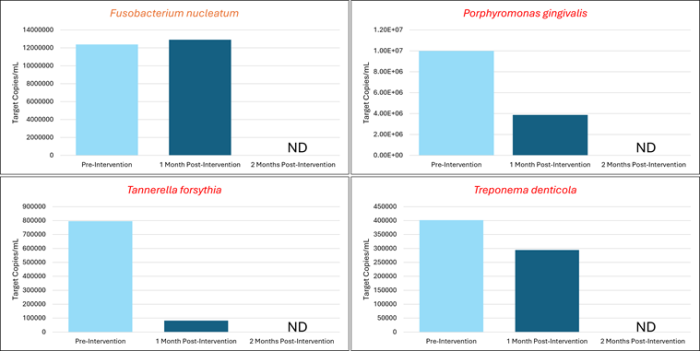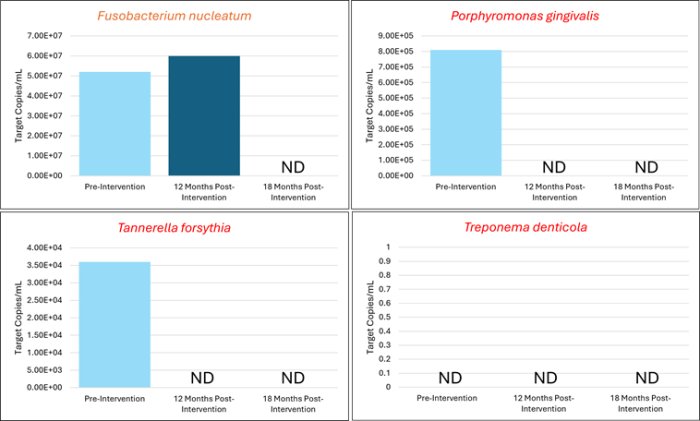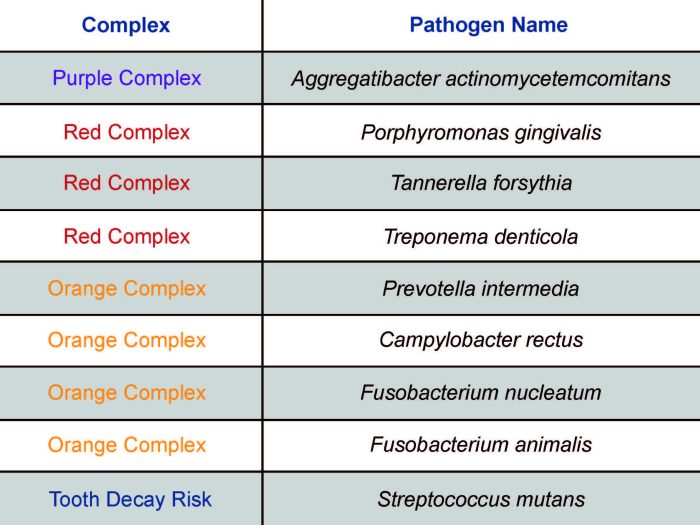ENJOY AN EXTRA 10% OFF YOUR FIRST ORDER
When you subscribe to ProBioraHealth.com emails
October 1, 2025
Over the past few years, a key theme has emerged in oral health care: it’s not enough to simply brush and floss. The real advances are coming from diagnostics that measure oral pathogens directly and guide targeted, patient-centered treatments. Among the most concerning pathogens are those in the red complex, a group of bacteria strongly linked to gum disease. Left unchecked, these bacteria cause gingivitis and periodontitis, leading to gum inflammation, tissue destruction, and even tooth loss.
Salivary diagnostic testing now allows clinicians to identify harmful bacteria- including red complex bacteria and others, track changes in their levels over time, and show patients measurable progress based on treatments tailored to their specific condition. This shift from assumption to data-driven care is transforming how we approach oral health.
Here, we share recent clinical results from real patients demonstrating how ProBiora3® probiotics play an important role in reducing oral pathogen load in the mouth and how we can use salivary diagnostic testing to track the outcomes.
The Protocol
The treatment protocol used for all patients presented here included:
| Phase | What was done |
| Baseline | Full salivary diagnostic test; measurement of key pathogens including red complex bacteria. |
| Phase 1 | Scaling & root planing to mechanically disrupt biofilms and remove deposits. |
| Phase 2 | 14‐day targeted antibiotic course of amoxicillin and metronidazole |
| Phase 3 | Daily use of SuperMouth’s daily fluoride rinse followed by ProBiora3® oral care probiotics to repopulate beneficial bacteria in the biofilm |
| Follow-Up Salivary Testing | Additional salivary diagnostic tests were performed between 1-12 months post Phases 1-3 |
Combined Results
Salivary diagnostic testing across 15 patients showed that the treatment protocol produced dramatic reductions in harmful oral bacteria. Overall, pathogen levels dropped by more than 90 percent, with two of the red complex species, Porphyromonas gingivalis and Treponema denticola, reduced to undetectable levels after treatment. Tannerella forsythia showed a reduction of more than 99 percent, while Fusobacterium nucleatum decreased by roughly 95 percent (Figure 1). These results demonstrate how the combined approach of scaling and root planing, an antibiotic course, and ongoing fluoride rinse and ProBiora3 probiotic use can shift the oral microbiome toward health and maintain those improvements over time.

Figure 1. Salivary diagnostic testing data before and after the Test, Treat, Repopulate Protocol. ND means that the oral pathogen was no longer detected following implementation of the protocol across all 15 patients.
While these combined results are impressive, individual case studies give us a closer look at how ProBiora3 works to protect oral health. We investigated both the length of time needed to significantly knock down oral pathogens following the Test, Treat, Repopulate Protocol and the long-term effects of the protocol on oral pathogen levels.
Case Study 1: Oral Pathogens Reduced to No Detection at 60 Days
Patient background: Male, mid-50s, high levels of red complex bacteria, elevated pathogen loads in the mouth, and a history of chronic periodontitis
Results: Salivary diagnostic testing was conducted on this patient at baseline, 1 month, and 2 months post protocol. At one month, a few oral pathogens were reduced, including P. gingivalis; however, Fusobacterium nucleatum actually increased in the mouth during this time period. The patient continued to follow the protocol, using SuperMouth’s fluoride rinse and ProBiora3 probiotics once daily. At 60 days, salivary diagnostic testing was repeated, and the patient no longer had any measurable oral pathogens in the mouth (Figure 2).

Figure 2. Salivary diagnostic testing data of a male, mid-50s, with high levels of oral pathogens. Three timepoints are presented- before the protocol intervention, 1 month after the intervention, and 2 months after the intervention. ND means that the oral pathogen was no longer detected following implementation of the protocol.
Interpretation: Within two months, the combined mechanical + antibiotic + ProBiora probiotic/ SuperMouth rinse strategy substantially altered the oral microbiome, reducing hard‐to‐treat red complex bacteria to undetectable levels in the mouth. This shows the protocol can work within 60 days with consistent patient compliance.
Case Study 2: Lasting Maintenance with ProBiora3
Patient background: Female, early 70s, high levels of oral pathogens and a history of chronic periodontitis
Results: Salivary diagnostic testing was conducted on this patient at baseline, 12 month, and 18 months post protocol. The patient continued to use SuperMouth oral rinse and ProBiora3 probiotics throughout the 18 month period. No additional dental treatment, other than routine cleaning, was provided during this time. The only oral pathogen that remained detectable at 12 months was Fusobacterium nucleatum; at 18 months this pathogen was also undetectable in the mouth (Figure 3).

Figure 3. Salivary diagnostic testing data of a female, early 70s, with high levels of oral pathogens. Three timepoints are presented- before the protocol intervention, 12 months after the intervention, and 18 months after the intervention. ND means that the oral pathogen was no longer detected following implementation of the protocol; this patient had no detectable levels of Treponema denticola prior to or after the dental intervention.
Interpretation: Combining traditional dental therapies that reduce the total microbial load in the mouth with ProBiora3 probiotics that repopulate healthy bacteria into the biofilm produces lasting reductions in oral pathogens more than one year after the initial intervention.
Looking Ahead
The Test, Treat, Repopulate Protocol demonstrates how combining diagnostic-driven care, mechanical therapy, targeted antibiotics, and ongoing ProBiora probiotic use can dramatically reduce oral pathogens, including the notoriously hard-to-treat red complex species, and maintain those improvements over the long term. While combined results highlight the overall effectiveness of the protocol, individual case studies reveal how consistent use of SuperMouth fluoride rinse and ProBiora3® oral care probiotics continues to protect and stabilize the oral microbiome months and even years after initial treatment. These findings underscore the value of personalized, data-driven oral care and provide a strong foundation for adopting this approach more widely in patients with elevated pathogen loads.
With ProBiora3® probiotics, lasting oral health isn’t just possible- it’s measurable. We invite dental professionals to apply this protocol with their most challenging periodontitis cases and share their outcomes to help shape future studies and expand the evidence base. If you have results you’d like to share, please email tech@probiorahealth.com.
